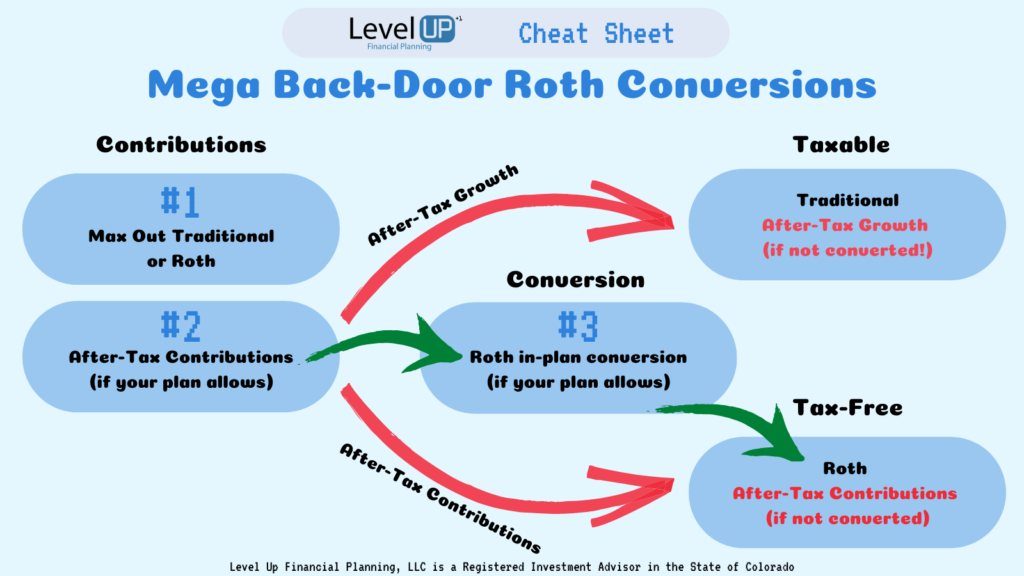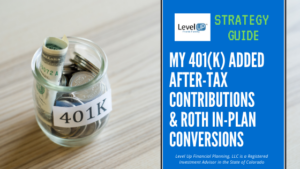Did your employer recently announce a couple of new features? Being able to make after-tax contributions and initiate Roth in-plan conversions is a game changer!
I love when these features are added to my clients’ 401(k) plans because it allows us to supercharge their retirement savings while implementing advanced tax-planning strategies that can save multiple thousands of dollars in taxes.
These work best when you use them together to implement what is called a “Mega Back-Door Roth Conversion”. More on that later, but first let’s tackle how each of these features works independently of each other.
Fair warning, these advanced strategies are only relevant if your income is greatly excessive to what you require for your monthly living expenses. You’ll see exactly why in just a second.
Related Podcast/ Video: What the Tech is a Backdoor ROTH?

Fast Travel Links
What are After-Tax Contributions
After-tax contributions allow you to contribute even more to your retirement accounts each calendar year. Before this new post-tax contribution was allowed, you were limited to the normal combined IRS limit for pre-tax (traditional) and Roth contributions.
For example, in 2020 the normal combined IRS limits are $19,500 + $6,500 (ages 50+)
Now, with the new after-tax contributions being allowed, you can add additional funds up to the total of $57,000 from (all sources, including employer matching and profit sharing). If you are age 50+, then the total is $63,500.
These contributions are after-tax, which means you’ve already paid federal and state taxes on these contributions. That means that those funds will not be taxed again. Unfortunately, the gains on these after-tax contributions will fall into the pre-tax traditional category, which will be taxed once withdrawn.
Fear not! That’s where Roth in plan conversions saves the day!
What Are Roth In-Plan Conversions
A Roth in-plan conversion allows you to convert non-Roth retirement funds into the Roth side. Why would you want to do that? Retirement funds that carry the Roth category have already been taxed and will never be taxed again!
Converting pre-tax traditional funds to a Roth would kick off a taxable situation because you need to recognize the converted amount as income. Remember that pre-tax, meaning that taxes hadn’t been paid on those funds.
What about those new after-tax contributions? That is where things get pretty interesting. By having both features now available, you can initiate your new Roth in-plan conversion on the after-tax contributions there is not a taxable event. ?
By doing this, the gains on the converted after-tax contributions will now grow tax-free under the Roth category. This is the notorious “Mega Back-Door Roth Conversion.”
Why Not Make Roth Contributions Outright?
There are a few reasons why you may not want to make Roth contributions outright.
- Your tax bracket is high and you want to receive the tax break on the first $19,500 of contributions pre-tax.
- This allows you to throw a lot more than $19,500 into your retirement account each year
- Roth IRA accounts are phased out at $139,000/individuals & $206,000/joint filers
When it comes to retirement income tax planning, it’s always good to run out projections to estimate what tax brackets you will fill up with traditional retirement account withdrawals. This will help you better understand how much Roth funds you should aim to create the most tax-efficient plan.
Do I Need to Combine After-Tax Contributions and Roth In-Plan Conversions?
You can actually use Roth in-plan conversion, even without making after-tax contributions. This is because any traditional funds you have in your account are eligible to be converted to a Roth account. You’ll want a detailed tax plan in place before making significant Roth in-plan conversions to ensure you are not crossing important phase-outs and that you are not paying a higher tax rate.
A huge mistake I’ve heard people make is converting 100% of their traditional funds to ROTH and popping into the highest tax bracket. You lose out on the valuable benefits of our unique progressive tax system when you have no taxable income at all. For example, a married couple in 2020 could have taxable income as high as $105,000 and still be in the 12% tax bracket!
Level Up! Should I Do a Roth Conversion This Year Strategy Guide
If you are able to take advantage of after-tax contributions, then you should also be doing Roth in-plan conversions. This is because after-tax contributions are less valuable if the growth is considered taxable income. By using the Roth in-plan conversions, you will make the growth on those contributions tax-free forever. This can add up to many thousands of dollars in tax-free growth and thus huge tax savings.
In addition to comprehensive financial planning where I help my clients create an in-depth tax plan, I also opened Power Up Tax Planning Services for those who only want tax planning assistance.
Connect with Level Up Financial Planning on any of our social platforms: LinkedIn Facebook Twitter

Lucas Casarez is a Certified Financial Planner™ Professional serving tech professionals virtually out of Fort Collins, CO
